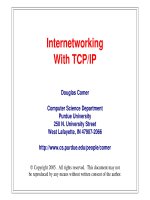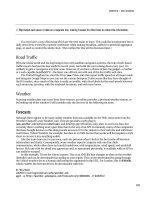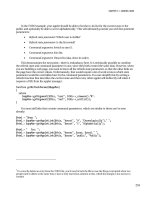Internetworking with TCP/IP- P32 pps
Bạn đang xem bản rút gọn của tài liệu. Xem và tải ngay bản đầy đủ của tài liệu tại đây (501.47 KB, 10 trang )
Routing: Exterior Gate way
Protocols And Autonomous
Systems (BGP)
15.1 Introduction
The previous chapter introduces the idea of route propagation and examines one
protocol routers use to exchange routing information. This chapter extends our under-
standing of internet routing architectures. It discusses the concept of autonomous sys-
tems, and shows a protocol that a group of networks and routers operating under one
administrative authority uses to propagate routing information about its networks to oth-
er groups.
15.2 Adding Complexity To The Architectural Model
The original core routing system evolved at a time when the Internet had a single
wide area backbone as the previous chapter describes. Consequently, part of the
motivation for a core architecture was to provide connections between a network at each
site and the backbone.
If
an internet consists of only a single backbone plus a set of at-
tached local area networks, the core approach propagates
all
necessary routing informa-
tion correctly. Because all routers attach to the wide area backbone network, they can
exchange all necessary routing information directly. Each router knows the single local
network to which it attaches, and propagates that infom~ation to the other routers. Each
router learns about other destination networks from other routers.
270
Routing: Exterior Gateway Protocols
And
Autonomous Systems (BGP) Chap.
15
It may seem that it would be possible to extend the core architecture to an arbitrary
size internet merely by adding more sites, each with a router connecting to the back-
bone. Unfortunately, the scheme does not scale
-
having all routers participate in a
single routing protocol only suffices for trivial size internets. There are three reasons.
First, even
if
each site consists of a single network, the scheme cannot accommodate an
arbitrary number of sites because each additional router generates routing traffic.
If
a
large set of routers attempt to communicate, the total bandwidth becomes overwhelm-
ing. Second, the scheme cannot accommodate multiple routers and networks at a given
site because only those routers that connect directly to the backbone network can com-
municate directly. Third, in a large internet, the networks and routers are not all
managed by a single entity, nor are shortest paths always used. Instead, because net-
works are owned and managed by independent groups, the groups may choose policies
that differ.
A
routing architecture must provide a way for each group to independently
control routing and access.
The consequences of limiting router interaction are significant. The idea provides
the motivation for much of the routing architecture used in the global Internet, and ex-
plains some of the mechanisms we will study. To summarize this important principle:
Although it is desirable for routers to exchange routing information, it
is impractical for all routers in an arbitrarily large internet to partici-
pate in a single routing update protocol.
15.3
Determining
A
Practical Limit On
Group
Size
The above statement leaves many questions open. For example, what size internet
is considered "large"?
If
only a limited set of routers can participate
in
an exchange of
routing information, what happens to routers that
are
excluded? Do they function
correctly? Can a router that is not participating ever forward a datagram to a router that
is participating? Can a participating router forward a datagram to a non-participating
router?
The answer to the question of size involves understanding the algorithm being used
and the capacity of the network that connects the routers as well as the details of the
routing protocol. There are two issues: delay and overhead.
Delay is easy to under-
stand. For example, consider the maximum delay until
all
routers are informed about a
change when they use a distance-vector protocol. Each router must receive the new in-
formation, update its routing table, and then forward the information to its neighbors.
In an internet with
N
routers arranged in a linear topology,
N
steps are required. Thus,
N
must
be
limited to guarantee rapid distribution of information.
The issue of overhead is also easy to understand. Because each router that partici-
pates in a routing protocol must send messages, a larger set of participating routers
means more routing traffic. Furthermore,
if
routing messages contain a list of possible
destinations, the size of each message grows as the number of routers and networks in-
Sec.
15.3
Determining
A
Practical
Limit
On
Group
Size
27
1
crease. To ensure that routing traffic remains a small percentage of the total traffic on
the underlying networks, the size of routing messages must be limited.
In
fact, most network managers do not have sufficient information required to per-
form detailed analysis of the delay or overhead. Instead, they follow a simple heuristic
guideline:
It is safe to allow up to a dozen routers to participate in a single rout-
ing infonnation protocol across a wide area network; approximately
Fve times
as
many can safely participate across a set of local area
networks.
Of course, the rule only gives general advice and there are many exceptions. For
example, if the underlying networks have especially low delay and high capacity, the
number of participating routers can
be
larger. Similarly,
if
the underlying networks
have unusually low capacity or a high amount of traffic, the number of participating
routers must
be
smaller to avoid overloading the networks with routing traffic.
Because an internet is not static, it can be difficult to estimate how much traffic
routing protocols will generate or what percentage of the underlying bandwidth the rout-
ing tdEc will consume. For example,
as
the number of hosts on a network grows over
time, increases in the traffic generated consume more of the network capacity.
In
addi-
tion, increased traffk can arise from new applications. Therefore, network managers
cannot rely solely on the guideline above when choosing a routing architecture. Instead,
they usually implement a
trafic monitoring
scheme. In essence, a traffic monitor
listens passively to a network and records statistics about the traffic.
In
particular, a
monitor can compute both the network utilization (i.e., percentage of the underlying
bandwidth being used) and the percentage of packets carrying routing protocol mes-
sages.
A
manager can observe traffic trends by taking measurements over long periods
(e.g., weeks or months), and can use the output to determine whether too many routers
are participating
in
a single routing protocol.
15.4
A
Fundamental Idea: Extra
Hops
Although the number of routers that participate in a single routing protocol must
be
limited, doing so has an important consequence because it means that some routers will
be
outside the group. It might seem that an "outsider" could merely make a member
of the group a default.
In
the early Internet, the core system did indeed function
as
a
central routing mechanism to which noncore routers sent datagrams for delivery. How-
ever, researchers learned an important lesson:
if
a router outside of a group uses a
member of the group as a default route, routing will be suboptimal. More
important,
one does not need a large number of routers or a wide area network
-
the problem can
occur whenever a nonparticipating router uses a participating router for delivery. To see
why, consider the example in Figure
15.1.
272
Routing: Exterior Gateway Protocols And Autonomous Systems
(BGP)
Chap.
15
Backbone Network
participating participating
router router
nonparticipating
router
Figure
15.1
An architecture that can cause the extra hop problem. Nonop-
timal routing
occurs
when a nonparticipating router connected to
the backbone has a default route to a participating router.
In
the figure, routers
R,
and
R,
connect to local area networks
1
and
2,
respective-
ly. Because they participate in a routing protocol, they both know how to reach both
networks.
Suppose nonparticipating router
R3
chooses one of the participating routers,
say
R,,
as a default. That is,
R3
sends
R,
all
datagrams destined for networks to which it
has no direct connection.
In particular,
R3
sends datagram destined for network
2
across the backbone to its chosen participating router,
R,,
which must then forward
them back across the backbone to router
R,.
The optimal route, of course, requires
R3
to transmit datagrams destined for network
2
directly to
R,.
Notice that the choice of
participating router makes no difference. Only destinations that lie beyond the chosen
router have optimal routes; all paths that go through other backbone routers require the
datagram to make a second, unnecessary trip across the backbone network. Also notice
that the participating routers cannot use ICMP redirect messages to inform
R,
that it has
nonoptimal routes because ICMP redirect messages can only
be
sent to the original
source and not to intermediate routers.
We call the routing anomaly illustrated in Figure
15.1
the
extra hop problem.
The
problem is insidious because everything appears to work correctly
-
datagrams do
reach their destination. However, because routing is not optimal, the system is extreme-
ly inefficient. Each datagram that takes an extra hop consumes resources on the inter-
mediate router as well as twice as much backbone bandwidth as it should. Solving the
problem requires us to change our view of architecture:
Treating a group of routers that participate in a routing update proto-
col as a default delivery system can introduce an extra hop for da-
tagram trafic; a mechanism is needed that allows nonparticipating
routers to learn routes from participating routers so they can choose
optimal routes.
Sec.
15.5
Hidden
Networks
15.5
Hidden
Networks
Before we examine mechanisms that allow a router outside a group to learn routes,
we need to understand another aspect of routing: hidden networks (i.e. networks that are
concealed from the view of routers
in
a group). Figure
15.2
shows
an
example that will
illustrate the concept.
Q-
router participating
Local Net
1
(I)
Local Net
2
Figure
15.2
An
example of multiple networks
and
routers with a single back-
bone connection.
A
mechanism is needed to pass reachability
information about additional
local
networks into the core system.
In
the figure, a site has multiple local area networks with multiple routers connect-
ing them. Suppose the site has just installed local network
4
and has obtained
an
Inter-
net address for it (for now, imagine that the site obtained the address from another ISP).
Also assume that the routers
R,,
R,,
and
R,
each have correct routes for all four of the
site's local networks as well as a default route that passes other traffic to the ISP's
router,
R,.
Hosts directly attached to local network
4
can communicate with one anoth-
er, and any computer on that network can route packets out to other Internet sites.
However, because router
R,
attaches only to local network
1,
it does not know about lo-
cal network
4.
We say that, from the viewpoint of the ISP's routing system, local net-
work
4
is
hidden
behind local network
I.
The important point is:
Because an individual organization can have an arbitrarily complex
set of networks interconnected by routers, no router from another or-
ganization can attach directly to all networks.
A
mechanism is need-
ed that allows nonparticipating routers to inform the other group
about hidden networks.
274
Routing: Exterior Gateway Protocols
And
Autonomous Systems (BGP)
Chap.
15
We now understand a fundamental aspect of routing: information must flow in two
directions. Routing information must flow from a group of participating routers to a
nonparticipating router, and a nonparticipating router must pass information about hid-
den networks to the group. Ideally, a single mechanism should solve both problems.
Building such a mechanism can be tricky. The subtle issues are responsibility and ca-
pability. Exactly where does responsibility for informing the group reside?
If
we de-
cide that one of the nonparticipating routers should inform the group, which one is ca-
pable of doing it? Look again at the example. Router
R4
is the router most closely as-
sociated with local network
4,
but it lies
2
hops away from the nearest core router.
Thus,
R4
must depend on router
R3
to route packets to network
4.
The point is that
R4
knows about local network
4
but cannot pass datagrams directly from
R,.
Router
R,
lies
one hop from the core and can guarantee to pass packets, but it does not directly attach
to local network
4.
So, it seems incorrect to grant
R3
responsibility for advertising net-
work
4.
Solving this dilemma will require us to introduce a new concept. The next
sections discuss the concept and a protocol that implements it.
15.6
Autonomous System Concept
The puzzle over which router should communicate information to the group arises
because we have only considered the mechanics of
an
internet routing architecture and
not the administrative issues. Interconnections, like those in the example of Figure
15.2, that arise because an internet has a complex structure, should not be thought of as
multiple independent networks connected to an internet. Instead, the architecture should
be thought of as a single organization that has multiple networks under its control. Be-
cause the networks and routers fall under a single administrative authority, that authori-
ty can guarantee that internal routes remain consistent and viable. Furthermore, the ad-
ministrative authority can choose one of its routers to serve as the machine that will ap-
prise the outside world of networks within the organization.
In
the example from Fig-
ure 15.2, because routers
R,, R,,
and
R4
fall under control of one administrative authori-
ty,
that authority can arrange to have
R3
advertise networks
2,
3,
and
4
(R,
already
knows about network
1
because it has a direct connection to it).
For purposes of routing, a group of networks and routers controlled by a single ad-
ministrative authority is called an
autonomous
system
(AS).
Routers within an auto-
nomous system are
free
to choose their own mechanisms for discovering, propagating,
validating, and checking the consistency of routes. Note that, under this definition, the
original Internet core routers formed
an
autonomous system. Each change in routing
protocols within the core autonomous system was made without affecting the routers in
other autonomous systems. In the previous chapter, we said that the original Internet
core system used
GGP to communicate, and a later generation used SPREAD. Eventu-
ally,
ISPs evolved their own backbone networks that use more recent protocols. The
next chapter reviews some of the protocols that autonomous systems use internally to
propagate routing information.
Sec. 15.7
From A Core To Independent Autonomous Systems
15.7
From A Core To Independent Autonomous Systems
Conceptually, the autonomous system idea was a straightforward and natural gen-
eralization of the original Internet architecture, depicted by Figure
15.2,
with auto-
nomous systems replacing local area networks. Figure
15.3
illustrates the idea.
System
1
Figure
153
Architecture of
an
internet with autonomous systems
at
backbone
sites. Each autonomous system consists of multiple networks
and routers under a single administrative authority.
To make networks that are hidden inside autonomous systems reachable
throughout the Internet, each autonomous system must advertise its networks to other
autonomous systems.
An
advertisement can be sent to any autonomous system.
In
a
centralized, core architecture, however, it is crucial that each autonomous system pro-
pagate information to one of the routers in the core autonomous system.
It may seem that our definition of an autonomous system is vague, but
in
practice
the boundaries between autonomous systems must
be
precise to allow automated algo-
rithms to make routing decisions. For example,
an
autonomous system owned by a cor-
poration may choose not to route packets through
an
autonomous system owned by
another even though they connect directly. To make it possible for automated routing
algorithms to distinguish among autonomous systems, each is assigned an
autonomous
system number
by the central authority that is charged with assigning all Internet net-
work addresses. When routers in two autonomous systems exchange routing informa-
tion, the protocol arranges for messages to carry the autonomous system number of the
system each router represents.
We can summarize the ideas:
A
large
TCPLIP
internet
has
additional structure to accommodate ad-
ministrative boundaries: each collection of networks and routers
managed by one administrative authority is considered to be a single
autonomous system that is free to choose an internal routing architec-
ture and protocols.
276
Routing: Exterior Gateway Protocols And Autonomous Systems (BGP) Chap.
15
We said that an autonomous system needs to collect information about all its net-
works and designate one or more routers to pass the information to other autonomous
systems. The next sections presents the details of a protocol routers use to advertise
network reachability. Later sections return to architectural questions to discuss
an
im-
portant restriction the autonomous system architecture imposes on routing.
15.8
An
Exterior Gateway Protocol
Computer scientists use the term Exterior Gateway Protocol (EGP)? to denote any
protocol used to pass routing information between two autonomous systems. Currently
a single exterior protocol is used in most
TCPJIP internets. Known as the Border Gate-
way Protocol (BGP), it has evolved through four (quite different) versions. Each ver-
sion is numbered, which gives rise to the formal name of the current version: BGP-4.
Throughout this text, the term BGP will refer to BGP-4.
When a pair of autonomous systems agree to exchange routing information, each
must designate a router* that will speak BGP on its behalf; the two routers
are
said to
become BGP peers of one another. Because a router speaking BGP must communicate
with a peer in another autonomous system, it makes sense to select a machine that is
near the "edge" of the autonomous system. Hence, BGP terminology calls the
machine a border gateway or border router. Figure
15.4
illustrates the idea.
Figure
15.4
Conceptual illustration of two routers,
R,
and
R,,
using
BGP
to
advertise networks in their autonomous systems after collecting
the information from other routers internally.
An
organization
using
BGP
usually chooses a router that is close to the outer
"edge" of the autonomous system.
In
the figure, router
R,
gathers information about networks in autonomous system
I
and reports that information to router
R2
using BGP, while router
R2
reports information
from autonomous system
2.
?Originally, the term
EGP
referred to a specific protocol that was used for communication with the Inter-
net core; the name was coined when the term
gateway
was used instead of
router.
.
$Although the protocol allows
an
arbitrary computer to
be
used, most autonomous systems run BGP on a
router; all the examples in this text will assume BGP is running on a router.
Sec.
15.9
BGP
Characteristics
277
15.9
BGP
Characteristics
BGP is unusual in several ways. Most important, BGP is neither a pure distance-
vector protocol nor a pure
link
state protocol. It can
be
characterized by the following:
Inter-Autonomous System Communication.
Because BGP is designed as an exteri-
or gateway protocol, its primary role is to allow one autonomous system to comrnuni-
cate with another.
Coordination Among Multiple BGP Speakers.
If
an autonomous system has multi-
ple routers each communicating with a peer in an outside autonomous system, BGP can
be
used to coordinate among routers in the set to guarantee that they all propagate con-
sistent information.
Propagation
Of
Reachability Information.
BGP allows an autonomous system to
advertise destinations that are reachable either in or through it, and to learn such infor-
mation from another autonomous system.
Next-Hop Paradigm.
Like distance-vector routing protocols, BGP supplies
next
hop
information for each destination.
Policy Support.
Unlike most distance-vector protocols that advertise exactly the
routes in the local routing table, BGP can implement policies that the local administra-
tor chooses. In particular, a router running BGP can
be
configured to distinguish
between the set of destinations reachable by computers inside its autonomous system
and the set of destinations advertised to other autonomous systems.
Reliable Transport.
BGP is unusual among protocols that pass routing information
because it assumes reliable transport. Thus, BGP uses TCP for all communication.
Path
Information.
In addition to specifying destinations that can
be
reached and a
next hop for each, BGP advertisements include path information that allows a receiver
to learn a series of autonomous systems along a path to the destination.
Incremental Updates.
To conserve network bandwidth, BGP does not pass full in-
formation
in
each update message. Instead,
full
information is exchanged once, and
then successive messages cany incremental changes called
deltas.
Support For Classless Addressing.
BGP supports CIDR addresses. That is, rather
than expecting addresses to
be
self-identifying, the protocol provides a way to send a
mask along with each address.
Route Aggregation.
BGP conserves network bandwidth by allowing a sender to
aggregate route information and send a single entry to represent multiple, related desti-
nations.
Authentication.
BGP allows a receiver to authenticate messages (i.e., verify the
identity of a sender).
278
Routing: Exterior Gateway Protocols
And
Autonomous Systems
(BGP)
Chap.
15
15.10 BGP Functionality And Message Types
BGP
peers perform three basic functions. The first function consists of initial peer
acquisition and authentication. The two peers establish a
TCP
connection and perform
a message exchange that guarantees both sides have agreed to communicate. The
second function forms the primary focus of the protocol
-
each side sends positive or
negative reachability information. That is, a sender can advertise that one or more des-
tinations are reachable by giving a next hop for each, or the sender can declare that one
or more previously advertised destinations
are
no longer reachable. The third function
provides ongoing verification that the peers and the network connections between them
are functioning correctly.
To handle the three functions described above,
BGP
defines four basic message
types. Figure 15.5 contains a summary.
Type Code Message Type Description
1
OPEN Initialize communication
2
UPDATE Advertise or withdraw routes
3
NOTIFICATION Response to an incorrect message
4
KEEPALIVE Actively test peer connectivity
Figure
155
The four
basic
message types
in
BGP-4.
15.1 1 BGP Message Header
Each
BGP
message begins with a fmed header that identifies the message type.
Figure
15.6
illustrates the header format.
0
16
24
31
-
-
-
MARKER
-
-
LENGTH
I
TYPE
Figure
15.6
The format of the header that precedes every BGP message.
The 16-octet
UARKER
field contains a value that both sides agree to use to mark
the beginning of a message. The Zoctet
LENGTH
field specifies the total message
length measured in octets. The minimum message size is
19
octets (for a message type
that has no data following the header), and the maximum allowable length is
4096
oc-









